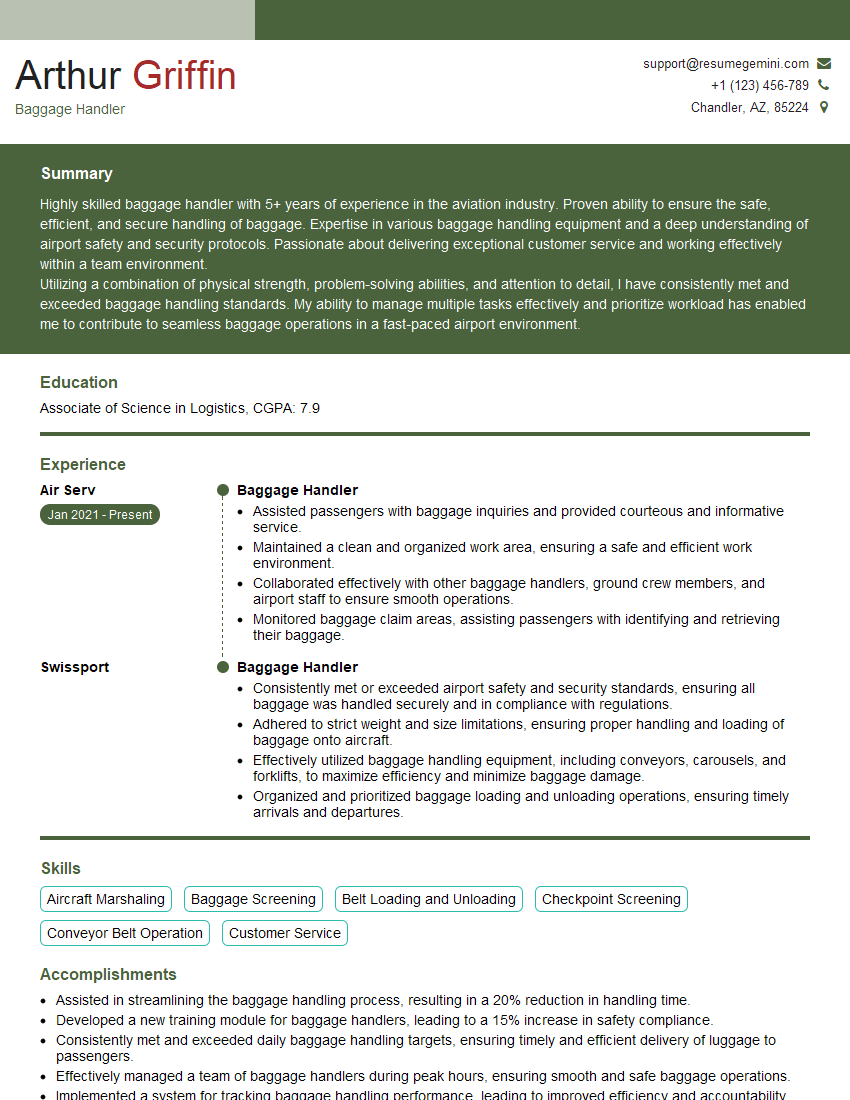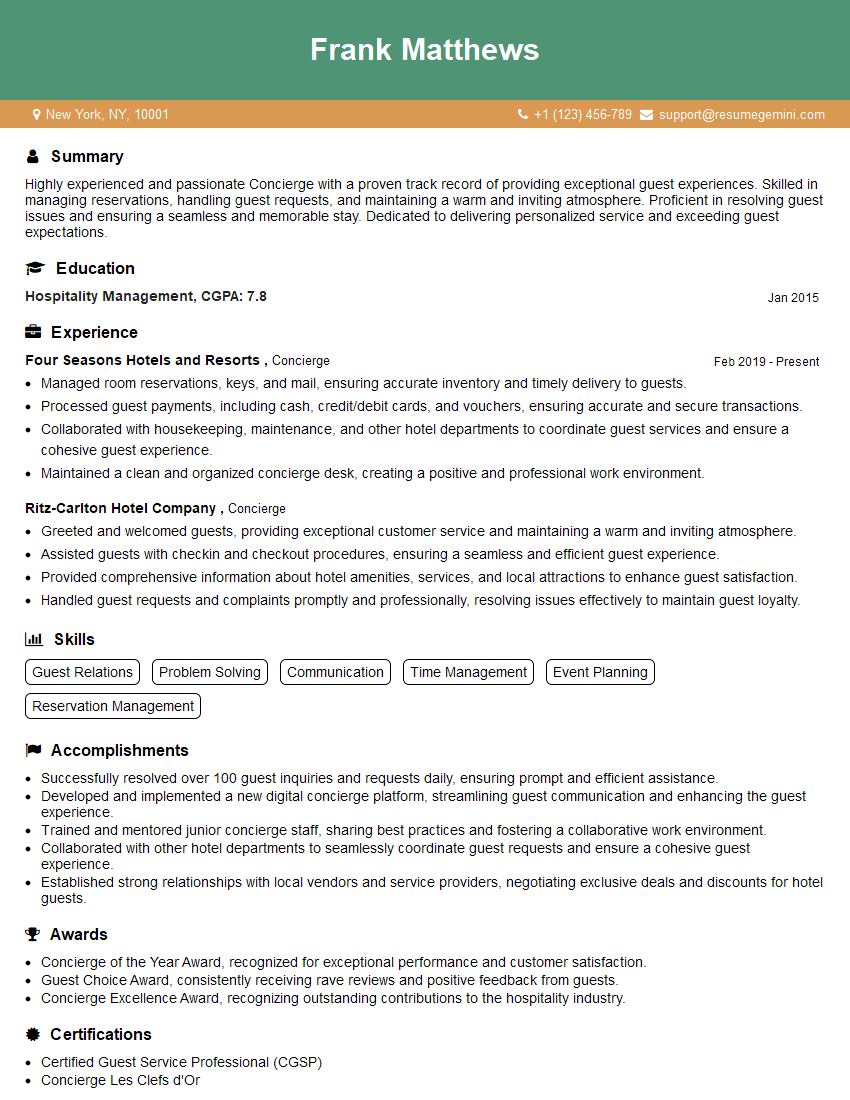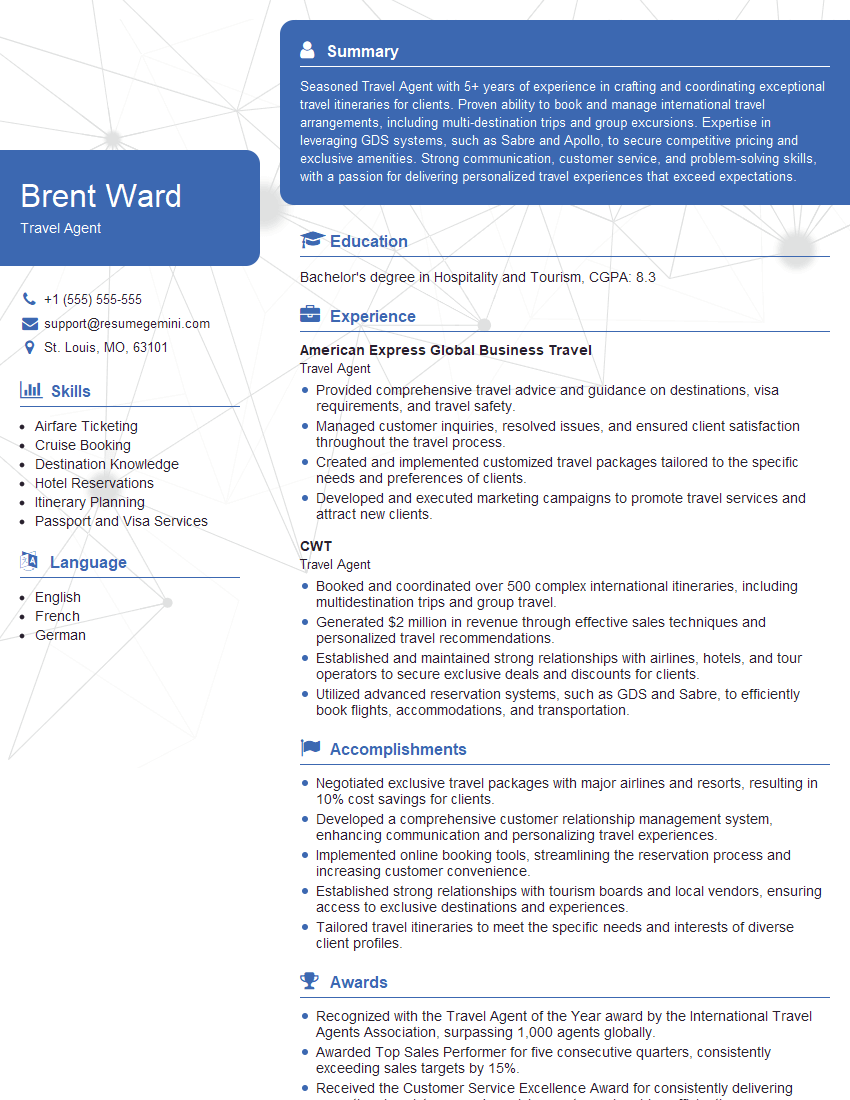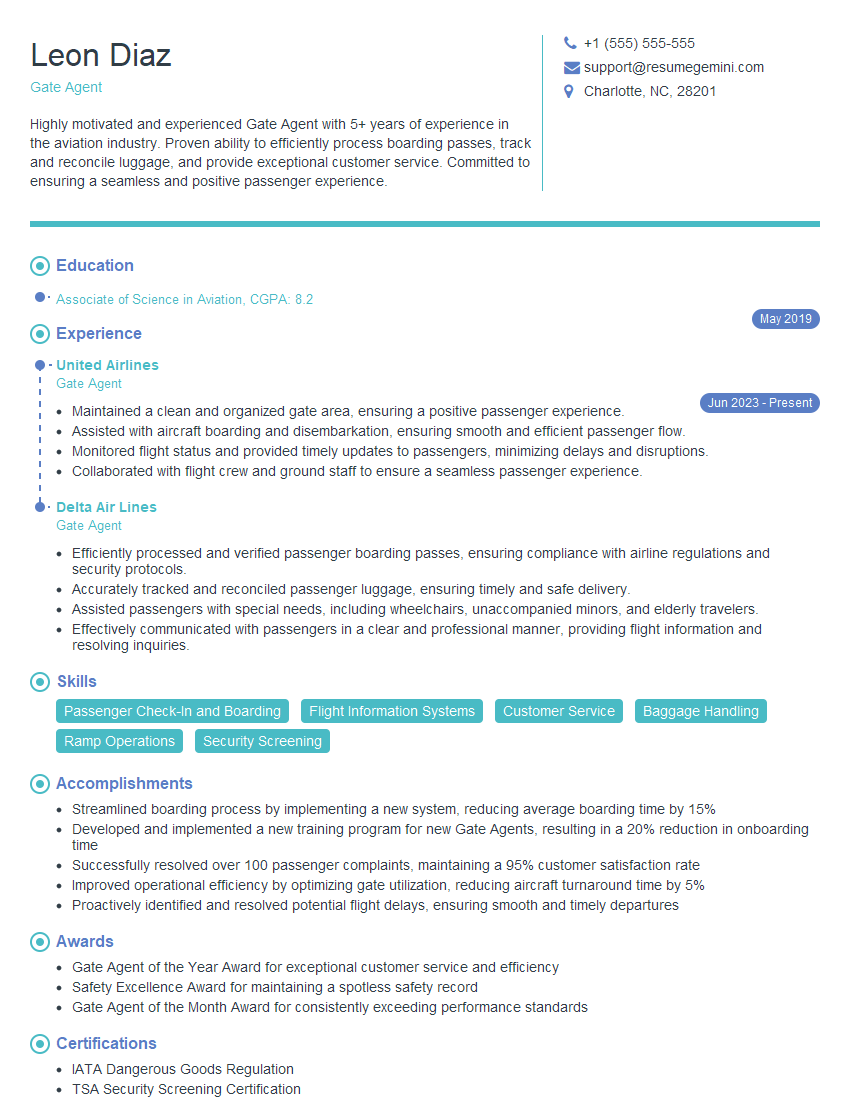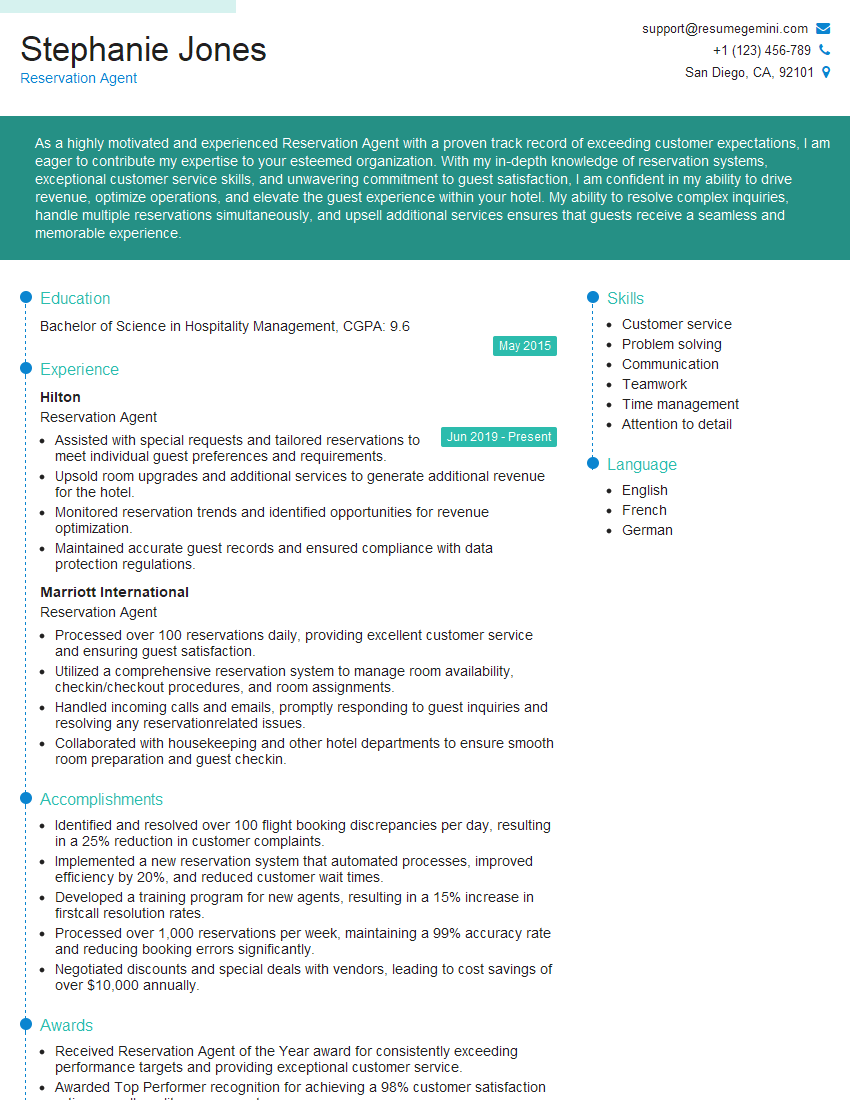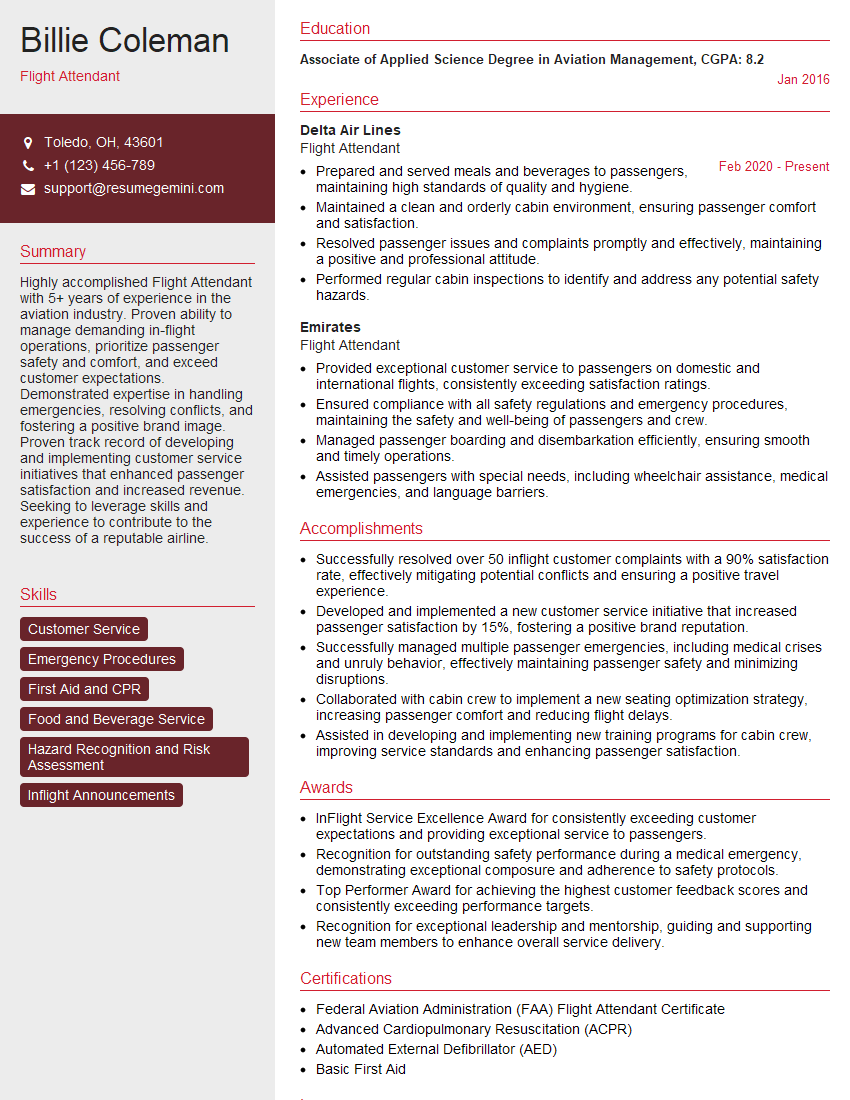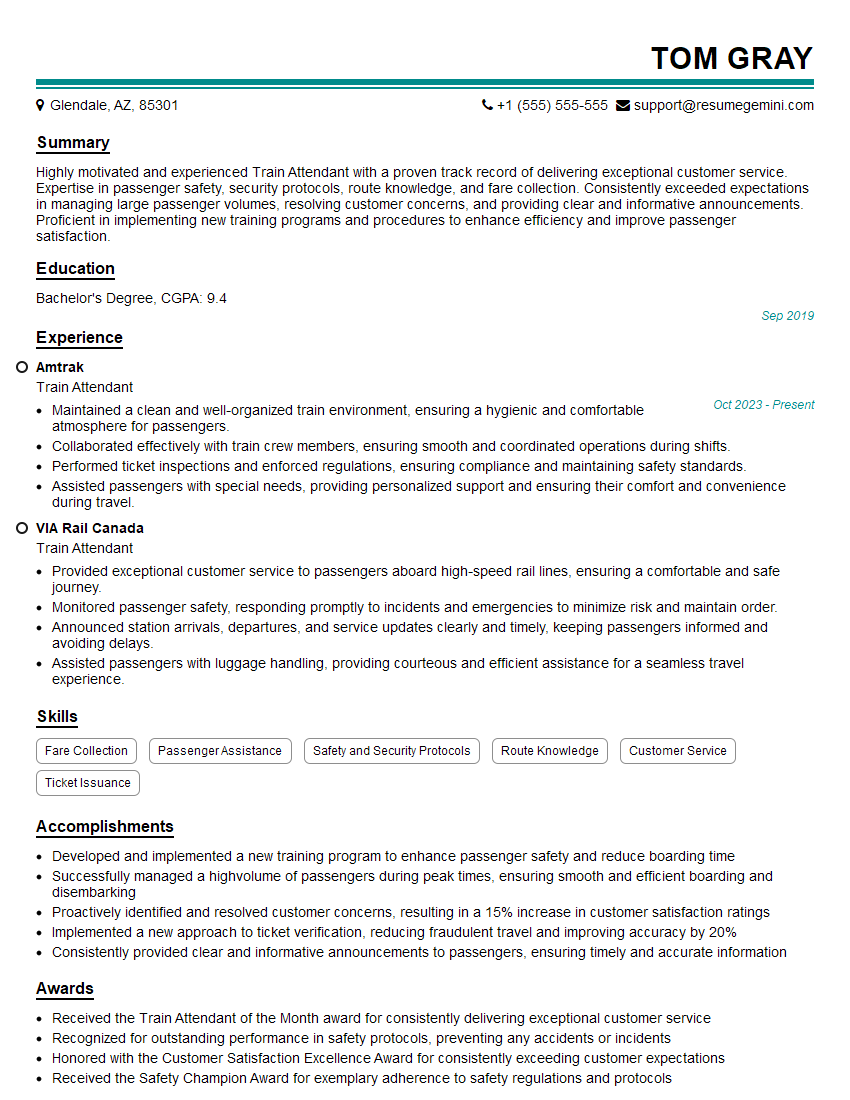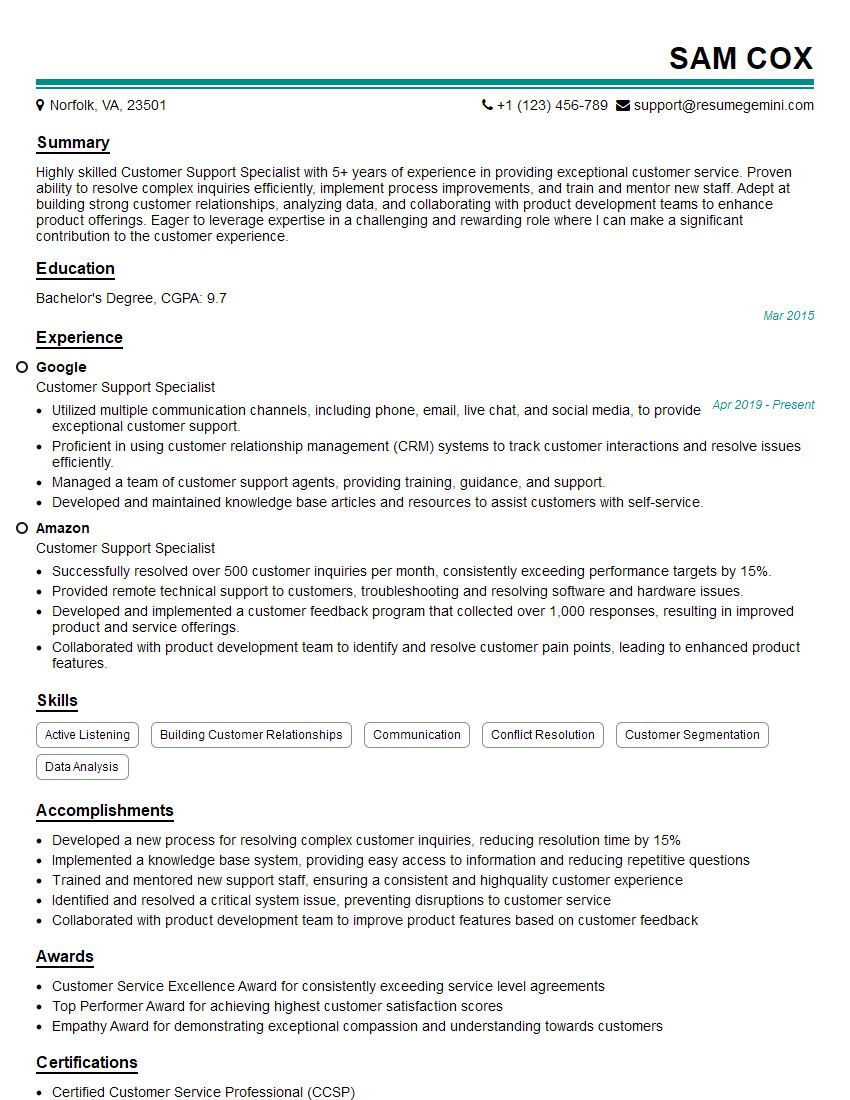Preparation is the key to success in any interview. In this post, we’ll explore crucial Customer Service and Passenger Assistance interview questions and equip you with strategies to craft impactful answers. Whether you’re a beginner or a pro, these tips will elevate your preparation.
Questions Asked in Customer Service and Passenger Assistance Interview
Q 1. Describe your experience handling difficult or irate customers.
Handling irate customers requires a calm and empathetic approach. My strategy focuses on active listening, validating their feelings, and finding solutions. I start by letting the customer vent without interruption, demonstrating that I’m truly hearing their concerns. Then, I use mirroring techniques – reflecting their emotions back to them in a calm, understanding tone – to help de-escalate the situation. For example, if a passenger is shouting about a missed connection, I might say, “I understand your frustration; missing a connecting flight is incredibly inconvenient.”
After acknowledging their feelings, I move to problem-solving. I clearly explain the situation, outlining any constraints or available options. If possible, I offer immediate solutions like rebooking on the next available flight, offering hotel accommodations, or providing compensation for the inconvenience. I always maintain a professional and respectful demeanor, even when facing verbal abuse. If the situation escalates beyond my ability to handle it, I promptly involve my supervisor.
In one instance, a passenger was furious about damaged luggage. By listening patiently, explaining the claims process clearly, and offering a complimentary upgrade on their next flight, I transformed their anger into gratitude. The key is to remain calm, empathetic, and solution-oriented, focusing on finding a fair resolution for the passenger.
Q 2. How do you prioritize tasks when dealing with multiple passenger requests simultaneously?
Prioritizing passenger requests when dealing with multiple demands simultaneously requires a systematized approach. I utilize a method that combines urgency, passenger vulnerability and impact. This is not strictly a ‘first-come, first-served’ system; I assess each situation based on its immediacy and potential consequences.
- Urgency: Passengers requiring immediate medical attention or those with imminent flight departures take precedence.
- Vulnerability: Passengers with disabilities, young children, or elderly individuals often need prioritized assistance.
- Impact: Situations that could significantly disrupt the operation of the airline or the comfort of other passengers (like a security issue) require swift action.
I use a combination of note-taking and internal communication tools to ensure that I keep track of all requests and their associated priorities. Visual cues, like color-coding notes or flagging urgent tasks within my workflow management system, are also vital. I regularly reassess priorities as new information arises or situations change. Effective communication with my colleagues is crucial to avoid duplicating efforts and ensure a consistent level of service to all passengers.
Q 3. Explain your understanding of ADA regulations regarding passenger assistance.
The Americans with Disabilities Act (ADA) mandates that airlines provide reasonable accommodations to passengers with disabilities. My understanding encompasses several key areas:
- Pre-boarding assistance: Airlines must offer assistance with boarding and deplaning to passengers who need it.
- Wheelchair assistance: Providing wheelchair access throughout the airport and onboard the aircraft.
- Service animals: Accommodating passengers traveling with service animals, ensuring they have appropriate space and care.
- Communication assistance: Providing communication aids (such as sign language interpreters) for passengers with hearing or speech impairments.
- Accessible seating: Making sure there are accessible seats available and ensuring that passengers with mobility aids can board the plane safely.
Failure to comply with ADA regulations can result in significant penalties. I am trained to identify and address the specific needs of passengers with disabilities, ensuring their travel experience is as comfortable and safe as possible. This involves understanding different disability types, appropriate communication strategies, and collaborating with airport personnel to provide seamless assistance.
Q 4. How would you handle a situation where a passenger misses their flight due to unforeseen circumstances?
When a passenger misses their flight due to unforeseen circumstances, my approach is to empathize, explain options, and offer solutions. I start by listening to their explanation and expressing understanding. Then, I clearly explain the airline’s policies regarding missed flights. This includes explaining fees associated with rebooking, available options for alternate flights (if any), and the possibility of compensation based on the cause of the missed flight (e.g., airline-caused delays).
Next, I actively work to find the best possible solution within the airline’s policies and the passenger’s needs. This might involve rebooking on the next available flight, offering travel vouchers for future use, suggesting alternative travel arrangements, or providing information about travel insurance claims. The goal is to provide options and help the passenger reach their destination with minimal disruption, keeping them informed every step of the way. Maintaining clear, transparent communication is paramount. In cases of airline fault, I ensure the passenger understands their right to compensation.
Q 5. What are your strategies for de-escalating tense situations with passengers?
De-escalating tense situations hinges on communication and empathy. My strategies focus on actively listening, validating concerns, and demonstrating a willingness to help.
- Active Listening: I let the passenger express their feelings without interruption, showing I’m paying attention through verbal and nonverbal cues (e.g., nodding, maintaining eye contact).
- Empathy: I reflect their feelings back to them to show understanding (“I understand this is frustrating”).
- Clear Communication: I speak calmly and clearly, using simple language, and avoiding jargon.
- Solution-Oriented Approach: I focus on finding solutions, not assigning blame. I present options and work collaboratively to find a mutually acceptable outcome.
- Setting Boundaries: If the passenger becomes abusive or threatening, I set clear boundaries, stating that abusive behavior is unacceptable and will not be tolerated. In such cases, I would involve my supervisor or security personnel.
An example of a successful de-escalation involved a passenger who was upset about a baggage delay. By calmly explaining the situation, providing updates on their luggage’s location, and offering a complimentary meal voucher, I transformed their anger into understanding and appreciation.
Q 6. Describe a time you went above and beyond to provide excellent customer service.
During a severe winter storm, many flights were significantly delayed and cancelled. A family with three young children was stranded, their connecting flight to visit a critically ill relative was cancelled. The parents were understandably distressed and distraught. Beyond simply rebooking them on the next available flight (which was several days later), I went the extra mile.
I contacted several hotels in the area, securing them a room at a discounted rate, confirming they provided cribs for the children. I then coordinated with the hotel to arrange airport transportation. I also personally helped them navigate the process of filing a claim with their travel insurance company. The gratitude they expressed was incredibly rewarding. This experience highlighted that going beyond standard procedures to provide genuine care can create lasting positive impressions and build customer loyalty.
Q 7. How familiar are you with airline/transportation industry regulations?
I possess a strong understanding of airline and transportation industry regulations. My knowledge encompasses:
- Passenger Rights: I am well-versed in passenger rights concerning delays, cancellations, baggage handling, and denied boarding compensation, varying by region and governing bodies like the EU261.
- Safety Regulations: I understand safety procedures regarding hazardous materials, emergency exits, and passenger security protocols.
- Operational Procedures: My experience covers flight scheduling, check-in processes, boarding procedures, baggage handling, and ground operations.
- International Regulations: I have familiarity with international travel regulations, visa requirements, and customs procedures.
- Disability Regulations: As previously mentioned, I have in-depth knowledge of ADA regulations and similar international accessibility standards.
Staying current with industry regulations is crucial, and I continuously update my knowledge through professional development courses, industry publications, and internal training sessions. This ensures I can provide accurate information and support to passengers and colleagues.
Q 8. How would you assist a passenger with limited mobility?
Assisting passengers with limited mobility requires a proactive and empathetic approach, focusing on individual needs and ensuring a safe and comfortable journey. It begins with understanding their specific requirements. This might involve wheelchair assistance, pre-boarding assistance, or special seating arrangements.
- Assessment: I would begin by politely inquiring about their specific needs and limitations, ensuring I understand any mobility aids they use (e.g., wheelchair, walker) and any additional support they require.
- Coordination: I would coordinate with ground handling agents and the cabin crew to ensure a smooth transition from check-in to boarding to deplaning. This may involve arranging for wheelchair transport from the curb to the gate and onto the aircraft, ensuring adequate space for their mobility aid on board, and coordinating assistance for bathroom breaks.
- Communication: Clear, concise, and frequent communication is crucial. I would keep the passenger informed about any delays or changes, and answer any questions they may have in a calm and reassuring manner. I would also ensure they have easy access to any information they might need, such as gate changes or connecting flight details.
- Safety: Safety is paramount. I would ensure all necessary safety procedures are followed, including securing their mobility aid during the flight. I’d also make sure they are aware of emergency exits and procedures, adapted to their needs.
For example, I once assisted a visually impaired passenger using a wheelchair. I provided constant verbal cues, guiding them carefully through each step of the journey, from check-in to their final destination, making sure they felt secure and confident.
Q 9. How do you handle complaints and feedback from passengers?
Handling passenger complaints and feedback is crucial for improving services and maintaining customer satisfaction. My approach is built on active listening, empathy, and a commitment to finding a fair and effective resolution.
- Active Listening: I would listen attentively to the passenger’s concerns, letting them fully express their thoughts and feelings without interruption. I would ask clarifying questions to ensure a thorough understanding of the issue.
- Empathy and Validation: I would acknowledge the passenger’s frustration and validate their feelings. Even if I can’t immediately resolve the issue, showing empathy can significantly reduce the passenger’s anger and frustration.
- Problem Solving: I would work with the passenger to identify a solution. This might involve offering a refund, compensation, or an alternative arrangement. If the issue requires further investigation, I would assure the passenger that I would follow up and keep them informed of the progress.
- Follow Up: After resolving the complaint, I would follow up with the passenger to ensure they are satisfied with the outcome. This shows that I value their feedback and am committed to providing excellent customer service.
- Documentation: Thorough documentation of all complaints and feedback is essential for tracking trends, identifying areas for improvement, and enhancing future service delivery.
For instance, a passenger once complained about a delayed baggage delivery. After listening attentively and confirming the issue, I initiated a thorough investigation, tracking the baggage and providing regular updates to the passenger until it was recovered and delivered. The follow up significantly improved passenger satisfaction despite the initial inconvenience.
Q 10. What is your experience with baggage handling procedures?
My experience with baggage handling procedures encompasses a comprehensive understanding of all aspects, from check-in to arrival, including lost baggage procedures. I am proficient in using baggage handling systems, identifying baggage irregularities, and troubleshooting potential issues.
- Check-in Procedures: I’m familiar with the process of checking baggage, including weighing, tagging, and loading onto the aircraft. This includes adherence to security regulations and the handling of oversized or overweight baggage.
- Baggage Tracking Systems: I have experience using various baggage tracking systems to monitor the location and status of baggage throughout its journey. This allows me to provide accurate updates to passengers and efficiently resolve any issues related to misplaced or delayed baggage.
- Lost and Found Procedures: I’m adept at handling reports of lost or damaged baggage, following established procedures to locate the baggage, file reports, and manage the claims process. This involves accurately documenting details of the missing item, liaising with various departments, and managing passenger expectations.
- Security protocols: I am fully aware of and adhere to all security protocols related to baggage handling to ensure passenger safety and security.
For example, I once successfully traced a passenger’s lost luggage using the airline’s baggage tracking system. I communicated consistently with the passenger, provided updates, and ultimately facilitated the return of their belongings, ensuring a positive resolution despite an initial stressful situation.
Q 11. How would you respond to a passenger who is experiencing a medical emergency?
Responding to a medical emergency requires swift action and a calm, decisive approach. Prioritizing the passenger’s safety and well-being is paramount.
- Immediate Assessment: I would immediately assess the situation, determining the nature of the emergency and the passenger’s condition. This might involve asking questions and observing their symptoms.
- Alerting Medical Personnel: I would immediately alert the appropriate medical personnel, either on board the aircraft or at the airport, providing them with the necessary information about the passenger’s condition and location.
- First Aid (if qualified): If I am qualified and trained in first aid, I would provide appropriate assistance while awaiting the arrival of medical professionals. This would involve following established protocols, prioritizing safety and providing comfort.
- Maintaining Order and Calm: I would strive to maintain order and calm among other passengers, minimizing disruption and ensuring their safety.
- Post-Incident Support: After the emergency, I would support the passenger and their family, providing any necessary assistance and arranging for further medical care if required.
While I am not medically trained to handle medical emergencies, I would prioritize contacting the relevant medical authorities and providing all the necessary support to ensure the passenger receives the right care.
Q 12. Describe your experience using customer relationship management (CRM) systems.
My experience with Customer Relationship Management (CRM) systems involves utilizing them to manage customer interactions, track service requests, and analyze customer data to improve service delivery. I’m proficient in using CRM systems for tasks such as data entry, customer communication, and report generation.
- Data Entry: I am skilled in accurately entering customer information into CRM databases, ensuring data integrity and accuracy.
- Customer Communication: I have used CRM systems to manage interactions with customers through various channels, such as email and phone, providing consistent and efficient service.
- Service Request Management: I have utilized CRM systems to log, track, and manage customer service requests, ensuring timely resolution and follow-up.
- Reporting and Analytics: I am familiar with generating reports and analyzing data from CRM systems to identify trends and areas for improvement in customer service.
For example, in a previous role, I utilized a CRM system to effectively track passenger inquiries, allowing for efficient follow up and ensuring consistency in service provided to repeat customers. This allowed us to identify areas of improvement and personalize interactions, improving overall customer satisfaction.
Q 13. What is your experience with ticketing and reservation systems?
My experience with ticketing and reservation systems extends to using various software platforms to process passenger bookings, manage ticketing, and handle related inquiries. I am familiar with various ticketing and reservation systems including their functionalities and procedures for handling bookings, cancellations, and changes.
- Booking Management: I am proficient in creating, modifying, and cancelling passenger bookings, ensuring accuracy and adherence to airline policies.
- Ticketing Procedures: I am familiar with various ticketing procedures, including issuing tickets, handling refunds, and managing upgrades.
- Reservation Management: I can effectively manage passenger reservations, addressing inquiries and resolving issues related to bookings, seat assignments, and baggage allowances.
- System Navigation: I’m adept at navigating and utilizing various ticketing and reservation systems efficiently and effectively.
For example, I have experience using Sabre and Amadeus systems to process passenger reservations and handle diverse scenarios, such as resolving booking conflicts or accommodating last-minute changes, all while maintaining a high level of accuracy and efficiency.
Q 14. How do you ensure passenger safety and security?
Ensuring passenger safety and security is a top priority. My approach involves adherence to established procedures, proactive risk assessment, and efficient response to potential threats.
- Security Procedures: I am fully trained in and adhere to all airport and airline security protocols. This includes screening procedures, baggage handling protocols, and emergency response plans.
- Risk Assessment: I actively assess potential safety and security risks and take appropriate measures to mitigate them. This includes identifying potential threats and reporting them to the appropriate authorities.
- Emergency Procedures: I am trained in emergency procedures and am prepared to respond effectively in a variety of situations, ranging from minor incidents to major emergencies. This includes understanding evacuation protocols and first aid procedures.
- Passenger Communication: I communicate clearly and effectively with passengers regarding safety and security procedures, including pre-flight briefings and emergency instructions.
For example, I have experience in coordinating emergency response and ensuring passengers are evacuated safely during a simulated emergency exercise, demonstrating my ability to calmly handle high-pressure situations while ensuring everyone’s safety.
Q 15. How do you handle lost or delayed baggage situations?
Handling lost or delayed baggage requires a calm, empathetic approach, focusing on immediate assistance and proactive communication. My first step is to verify the passenger’s details and baggage information, using their baggage tag number. I’ll then input this information into the airline’s baggage tracking system to determine its location and status.
If the baggage is simply delayed, I provide the passenger with an estimated arrival time and arrange for delivery to their destination, often offering a courtesy call to confirm. I ensure they have essential toiletries and clothing, sometimes arranging for a small allowance for immediate needs. If the baggage is lost, the process is more involved. I file a formal lost baggage report, providing the passenger with a reference number for tracking. I explain the process, including the timeframe for investigation and compensation claims, and provide contact information for further updates. Throughout, I maintain open communication, providing regular updates and addressing passenger concerns with patience and understanding.
For example, I once assisted a family whose baggage was delayed on a connecting flight. Their child’s medication was in the missing bag. I immediately contacted our ground services team to expedite delivery, providing them with copies of the prescription and tracking information. Meanwhile, I personally sourced an emergency supply of medication for the child from our first-aid kit. The family was incredibly relieved, and their positive feedback highlighted the importance of proactive problem-solving and empathy.
Career Expert Tips:
- Ace those interviews! Prepare effectively by reviewing the Top 50 Most Common Interview Questions on ResumeGemini.
- Navigate your job search with confidence! Explore a wide range of Career Tips on ResumeGemini. Learn about common challenges and recommendations to overcome them.
- Craft the perfect resume! Master the Art of Resume Writing with ResumeGemini’s guide. Showcase your unique qualifications and achievements effectively.
- Don’t miss out on holiday savings! Build your dream resume with ResumeGemini’s ATS optimized templates.
Q 16. How would you assist a passenger with language barriers?
Assisting passengers with language barriers requires resourcefulness and a commitment to clear communication. My initial approach involves observing nonverbal cues and using simple, clear language. I utilize translation apps or websites to bridge communication gaps, ensuring accurate translation of vital information like flight details, gate changes, or safety procedures. If possible, I’ll try to locate a bilingual staff member or volunteer who can assist. I make sure to speak slowly and clearly, using visual aids whenever possible. I also rely heavily on nonverbal communication – smiling, nodding, and using gestures to ensure understanding. Crucially, I maintain patience and a respectful attitude, ensuring the passenger feels heard and understood, regardless of the language barrier.
For instance, I once assisted a non-English speaking passenger who was experiencing difficulty navigating the airport. Using a translation app, I helped them understand the boarding process, found their gate, and even helped them locate a wheelchair. While the process was slightly slower, focusing on calm, clear communication made all the difference, resulting in a positive interaction for the passenger and a sense of accomplishment for me.
Q 17. Describe your problem-solving skills in a customer service context.
My problem-solving approach in customer service is systematic and customer-centric. I begin by actively listening to the passenger’s concern, clarifying the issue to ensure I fully understand their needs. I then analyze the situation, identifying the root cause of the problem and considering all possible solutions. I prioritize solutions that are both efficient and customer-focused. Once a solution is chosen, I explain it clearly to the passenger, ensuring they understand the steps involved and the expected outcome. Throughout this process, I maintain a professional and empathetic demeanor, keeping the passenger informed and involved.
For example, a passenger once complained about a damaged item in their checked luggage. After listening to their concerns and examining the damage, I followed company protocol by documenting the incident with photographs and obtaining the required forms. I explained the compensation process, assured them about the next steps, and promptly filed their claim, maintaining contact throughout to keep them updated on its progress.
Q 18. How do you maintain professionalism under pressure?
Maintaining professionalism under pressure relies on effective self-management and a proactive approach. I remain calm and composed, even in stressful situations, focusing on solving the problem at hand. I utilize deep breathing exercises to manage stress and anxiety. I prioritize clear communication, addressing passengers’ concerns with empathy and respect. Furthermore, I rely on my training and experience to quickly assess situations and implement appropriate solutions efficiently and calmly. This includes knowing company policies and procedures and having access to the necessary resources.
For example, during a sudden security alert, I remained calm and followed established emergency procedures. While other passengers were becoming agitated, I used clear, reassuring language to explain the situation and guide them to safety. Maintaining my composure allowed me to keep them calm and confident.
Q 19. What are your strategies for time management in a fast-paced environment?
Effective time management in a fast-paced environment requires prioritization, planning and organization. I utilize task management tools to track my responsibilities, setting deadlines for each task to ensure timely completion. I prioritize tasks based on urgency and importance, focusing on the most critical needs of the passengers first. I am adept at multitasking, handling multiple inquiries simultaneously without compromising the quality of service. I effectively utilize breaks to recharge, ensuring I maintain optimal efficiency and avoid burnout.
For instance, during peak check-in hours, I prioritize passengers with connecting flights or those who require special assistance. I utilize quick, efficient procedures without sacrificing attention to detail or customer service quality.
Q 20. How do you adapt to changing priorities and unexpected situations?
Adapting to changing priorities and unexpected situations requires flexibility, resourcefulness and proactive problem solving. I remain open to change and adapt my approach based on the evolving needs of the situation. I prioritize critical tasks while still addressing other tasks efficiently. I regularly communicate with my team and supervisors to share updates and request assistance when needed. My ability to improvise and find creative solutions is crucial in maintaining smooth operations and excellent customer service.
For example, a sudden flight cancellation required me to quickly rebook affected passengers on alternative flights, coordinate with ground staff, and manage their anxieties. By prioritizing passengers’ needs, communicating effectively with all stakeholders, and accessing the available resources, I managed the disruption effectively, minimizing passenger inconvenience.
Q 21. How do you use technology to improve customer service?
Technology plays a vital role in enhancing customer service. I utilize passenger service systems (PSS) for efficient baggage tracking, flight updates, and passenger information management. I use online chat platforms and mobile apps to provide immediate assistance and proactively address passenger inquiries. I leverage social media monitoring tools to identify and respond to passenger feedback and concerns promptly. I regularly update my knowledge of new technologies and their applications in passenger assistance to improve the quality of customer service.
For example, I frequently use the airline’s mobile app to send proactive notifications to passengers regarding flight changes or gate updates, minimizing confusion and delays. I utilize online chat to answer basic questions quickly, freeing up time to assist passengers with more complex needs in person.
Q 22. Describe your experience working with diverse passenger populations.
Throughout my career, I’ve had the pleasure of interacting with a remarkably diverse passenger population. This includes individuals from various cultural backgrounds, age groups, and with a wide range of abilities. I’ve found that effective communication is key; this involves being mindful of cultural nuances, speaking clearly and patiently, and being sensitive to individual needs and communication styles. For example, I’ve learned the importance of non-verbal cues and adapting my communication approach based on the passenger’s apparent comfort level. I’ve worked with passengers who are visually impaired, hearing impaired, or have other mobility challenges, and I’ve consistently prioritized providing them with personalized assistance to ensure a smooth and comfortable journey. This experience has significantly enhanced my empathy and ability to connect with people from all walks of life.
Q 23. How do you ensure customer satisfaction?
Ensuring customer satisfaction is paramount in my approach to passenger assistance. I believe it’s a multifaceted process that begins with proactive and attentive service. This involves anticipating passenger needs, addressing concerns promptly, and providing clear and concise information. For instance, if a passenger is anxious about a flight delay, I would proactively offer updates, explain the reasons for the delay, and provide alternative options if available. I actively listen to passenger feedback, both positive and negative, using it as an opportunity for improvement. A positive attitude and a genuine willingness to help go a long way in building rapport and trust. Finally, I strive to go the extra mile; a small gesture of kindness, like offering a complimentary beverage or assisting with luggage, can significantly enhance the passenger experience.
Q 24. How familiar are you with different types of passenger needs (e.g., families, elderly, disabled)?
I am highly familiar with the diverse needs of different passenger demographics. Working with families requires understanding the unique challenges of traveling with children, from managing strollers and car seats to ensuring their comfort and safety. With elderly passengers, I prioritize providing assistance with boarding, baggage handling, and navigating the airport. This often involves extra patience and understanding of their potential mobility limitations. When assisting disabled passengers, I adhere strictly to accessibility guidelines, providing appropriate accommodations and assistance based on their specific needs. This may include wheelchair assistance, providing information in alternative formats, and coordinating with special assistance teams. Understanding these varying needs is crucial for providing truly inclusive and positive travel experiences.
Q 25. What is your experience with security protocols and procedures?
I have extensive experience with airport security protocols and procedures. I am thoroughly familiar with TSA regulations, screening processes, and prohibited items. I am trained to identify suspicious behavior and report it to the appropriate authorities. My experience includes assisting passengers with the screening process, ensuring they understand the procedures and comply with all regulations. I am adept at handling situations involving forgotten or prohibited items, finding solutions within the parameters of security regulations to minimize disruption to the passenger’s travel plans. Maintaining passenger safety and security is always my top priority, and I strictly adhere to all established protocols.
Q 26. How do you handle situations involving unruly or disruptive passengers?
Handling unruly or disruptive passengers requires a calm and decisive approach. My first priority is ensuring the safety and well-being of all passengers and crew. I begin by attempting to de-escalate the situation through calm and empathetic communication, actively listening to the passenger’s concerns and attempting to understand their perspective. If communication fails to resolve the issue, I follow established protocols, which may include alerting security personnel or law enforcement, depending on the severity of the situation. Documentation of the incident is crucial, including detailed notes on the passenger’s behavior, the steps taken to address the situation, and any witnesses involved. My focus is always on resolving the situation effectively and safely, while maintaining a professional demeanor throughout the process.
Q 27. How would you resolve a conflict between two passengers?
Resolving conflicts between passengers requires a neutral and impartial approach. I begin by actively listening to both parties, ensuring each has the opportunity to explain their perspective without interruption. I aim to identify the root cause of the conflict and find common ground. I facilitate communication between the passengers, encouraging them to find a mutually acceptable solution. If a resolution cannot be reached through mediation, I may need to involve supervisory personnel or security, depending on the nature and severity of the dispute. Throughout the process, I maintain a calm and professional demeanor, focusing on de-escalating the situation and promoting a peaceful environment for all passengers. My goal is always to find a fair and reasonable resolution that satisfies both parties as much as possible.
Q 28. Describe your experience with passenger check-in procedures.
I have extensive experience with passenger check-in procedures, including both traditional counter check-in and online/mobile check-in processes. My responsibilities include verifying passenger identification, checking baggage, issuing boarding passes, and providing information about flight details, baggage allowance, and security procedures. I’m proficient in using various check-in systems and technologies. I’m also adept at assisting passengers with special needs during the check-in process, ensuring they have the necessary assistance and accommodations. I understand the importance of efficiency and accuracy during check-in, ensuring a smooth and seamless start to the passenger’s journey. I consistently strive to provide a welcoming and helpful experience, making the check-in process as stress-free as possible for all passengers.
Key Topics to Learn for Customer Service and Passenger Assistance Interview
- Understanding Passenger Needs: Learn to identify and prioritize diverse passenger needs, considering various factors like age, disability, and language barriers. Practical application: Role-playing scenarios to practice empathetic communication and problem-solving in challenging situations.
- Effective Communication Techniques: Master active listening, clear and concise verbal and written communication, and conflict resolution skills. Practical application: Develop strategies for handling difficult conversations, complaints, and stressful situations with composure and professionalism.
- Safety and Security Procedures: Familiarize yourself with relevant safety regulations, emergency protocols, and security procedures specific to the passenger assistance role. Practical application: Understanding how to respond effectively during security breaches, medical emergencies, or other unexpected events.
- Problem-Solving and Decision-Making: Develop critical thinking skills to analyze situations, identify solutions, and make informed decisions under pressure. Practical application: Practice assessing situations quickly, prioritizing tasks, and implementing effective solutions.
- Technology Proficiency: Become familiar with relevant software and systems used for passenger management, ticketing, and communication. Practical application: Research common systems used in the industry and understand their basic functionalities.
- Teamwork and Collaboration: Understand the importance of effective teamwork and collaboration with colleagues to ensure seamless passenger service. Practical application: Consider scenarios where teamwork is crucial and how to contribute effectively.
- Company Policies and Procedures: Thoroughly review the specific policies and procedures of the company you are interviewing with. Practical application: Demonstrate your understanding of these policies during the interview.
Next Steps
Mastering Customer Service and Passenger Assistance skills opens doors to rewarding careers with excellent growth potential. A strong resume is crucial for showcasing your abilities and securing your dream job. Creating an ATS-friendly resume significantly increases your chances of getting noticed by recruiters. ResumeGemini is a trusted resource for building professional, impactful resumes that highlight your skills and experience. Examples of resumes tailored specifically for Customer Service and Passenger Assistance roles are available to help you craft a compelling application. Invest in your future – build a resume that reflects your potential!
Explore more articles
Users Rating of Our Blogs
Share Your Experience
We value your feedback! Please rate our content and share your thoughts (optional).
What Readers Say About Our Blog
Hi, I’m Jay, we have a few potential clients that are interested in your services, thought you might be a good fit. I’d love to talk about the details, when do you have time to talk?
Best,
Jay
Founder | CEO


